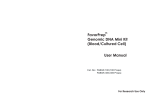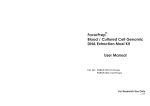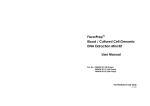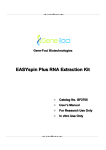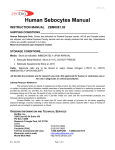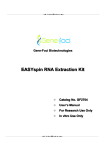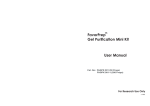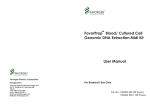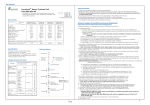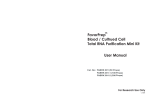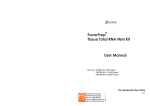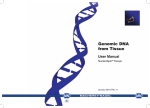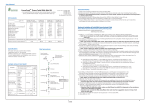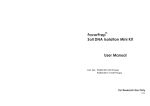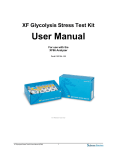Download User Manual FavorPrep Genomic DNA Mini Kit (Blood/Cultured Cell)
Transcript
TM FavorPrep Genomic DNA Mini Kit (Blood/Cultured Cell) User Manual Cat. No.: FABGK 100 (100 Preps) FABGK 300 (300 Preps) For Research Use Only Kit Contents v. Add 200 μl of FATG Buffer to the tube and resuspend the cell pellet by vortex or pipetting. FABGK 100 (100 Preps) FABGK 300 (300 Preps) 135 ml 30 ml 405 ml 75 ml FABG Buffer 40 ml 100 ml W1 Buffer 45 ml 130 ml 25 ml 50 ml 30 ml 75 ml FABG Column 100 pcs 300 pcs 2 ml Collection Tube 200 pcs 600 pcs Cat. No. / preps RBC Lysis Buffer FATG Buffer Wash Buffer* (concentrated) Elution Buffer *Add 100 ml / 200 ml of ethanol (96~100%) to Wash Buffer when first open. vi. Incubate at room temperature for 5 minutes, and then follow the Cultured Cell Protocol starting from Step 2 (Cell Lysis). Troubleshooting: Low yield • Too many cells were used --reduce the sample volume. • Poor cell lysis because of insufficient Proteinase K activity --Use a fresh or well-stored Proteinase K stock solution. • Poor cell lysis because of insufficient mixing with FABG buffer --Mix the sample and FABG Buffer immediately and thoroughly by pulse-vortexing. • Poor cell lysis because of insufficient incubation time --Extend the incubation time and make sure that no residual particulates remain. • Ethanol is not added into the lysate before transferring into FABG Midi Column • Ethanol is not added into Wash Buffer when first open; the volume or the percentage of ethanol is not correct before adding into Wash Buffer. Specification Sample Size: Up to 300 μl of Whole blood Up to 200 μl of frozen blood Up to 200 μl of buffy coat Up to 1 x 10 7 of Cultured animal cells Up to 1 x 10 9 of Cultured bacterial cells Up to 5 x 10 7 of Fungus cells Average Yield: about 50 μg Format: spin column Handling time: within 60 minutes Important Notes • Elution of genomic DNA is not efficient --Make sure the pH of ddH2O is between 7.5- 8.5. --After Elution Buffer or ddH2O is added, stand the FABG Midi Column for 5-10 min before centrifugation. Column is clogged •Blood sample contains clots --Mix the blood sample well with anti-coagulant to prevent formation of blood clots. •Sample is too viscous --Reduce the sample volume. Purified DNA dose not perform well in downstream application 1. Buffers provided in this system contain irritants. Wear gloves and lab coat when handling these buffers. 2. For Cat. No. FABGK 100, add 100 ml of ethanol (96~100%) to Wash Buffer when first open. For Cat. No. FABGK300, add 200 ml of ethanol (96~100%) to Wash Buffer when first open. 1 •Sample is old --Always use fresh or well-stored sample for genomic DNA extraction. •Residual ethanol contamination --After Wash step, centrifuge at 4,000 x g for an additional 10 minutes to dry the FABG Midi Column. •RNA contamination 10 Special Protocol: Brief Procedure (For Bacteria) Step 1-Sample Preparation A. For Gram-negative bacteria: Fresh Blood 9 i. Transfer the appropriate number of bacterial cell (up to 1 x 10 ) to a 1.5ml microcentrifuge tube (not provided) and centrifuge at full speed (14,000 rpm or 10,000 x g) for 1 minute. Then discard the supernatant. ii. Add 200 μl of FATG Buffer and resuspend the pellet by vortex or pipetting. Incubate for 5 minutes at room temperature. RBC lysis iii. Follow the Cultured Cell Protocol starting from Step 2 (Cell Lysis). B. For Gram-positive bacteria: 9 i. Transfer the appropriate number of bacterial cell (up to 1 x 10 ) to a 1.5ml microcentrifuge tube (not provided) and centrifuge at full speed (14,000 rpm or 10,000 x g) for 1 minute. Then discard the supernatant. Cell lysis (FABG) ii. Add 200 μl of lysozyme buffer (20 mg/ml lysozyme; 20 mM Tris-HCl; 2 mM EDTA; 1% Triton X-100, pH 8.0; prepare fresh lysozyme buffer immediately prior to use) and resuspend the pellet by vortex or pipetting. Binding iii. Incubate for 10 minutes at room temperature. During incubation, invert the tube every 2-3 minutes. iv. Follow the Cultured Cell Protocol starting from Step 2 (Cell Lysis). Special Protocol: (For Fungus) Washing (W1 Buffer) (Wash Buffer) centrifuge Step 1-Sample Preparation i. centrifuge 7 Harvest appropriate number of fungus cell (up to 5 x 10 ) to a 1.5ml microcentrifuge tube (not provided) and centrifuge at 5,000 x g for 10 minute. Then discard the supernatant. ii. Add 600 μl of sorbitol buffer (1.2 M sorbitol; 10 mM CaCl 2 ; 0.1 M Tris-HCl pH 7.5; 35mM ß-mercaptoethanol) and resuspend the pellet. Elution (Elution Buffer) centrifuge Pure genomic DNA iii. Add 200 U of lyticase or zymolase. Incubate for 30 minutes at 30ºC. iv. Centrifuge the mixture at 2,000 x g for 10 minutes to harvest the spheroplast, and then remove the supernatant. 9 2 Genernal Protocol: (For Fresh Blood) Please Read Important Notes Before Starting The Following Steps. Step 1 – RBC Lysis Special Protocol: (For Cultured Cell) Step 1-Sample Preparation A. For Cultured Animal Cells: 1. Collect fresh human blood in an anticoagulant-treat collection tube. 2. Transfer up to 300μl fresh blood to a 1.5ml microcentrifuge tube (not provided). If the sample is more than 300 μl (up to 1 ml), add the sample to a sterile 15 ml centrifuge tube. 3. Add 3 x the sample volume of RBC Lysis Buffer and mix by inversion. Do not vortex. 4. Incubate at room temperature for 10 minutes. 5. Centrifuge at 3,000 x g for 5 minutes and completely remove the supernatant. 6. Resuspend the pellet with 100 μl of RBC Lysis Buffer. Step 2 – Cell Lysis 7. Add 200 μl of FABG Buffer and mix by vortex. 8. Incubate for 10 minutes at room temperature or until the sample lysate is clear. During incubation, invert the tube every 3 minutes. 9. Preheat required Elution Buffer (for Step 5 DNA Elution) in a 70ºC water bath. 10. (Optional Step): If RNA-free genomic DNA is required, add 5μl of 10 mg/ml RNase A to the sample and mix by vortex. Then incubate for 5 minutes at room temperature. i. Trypsinize the adherent cells before harvesting. 7 ii. Transfer the appropriate number of cell (up to 1 x 10 ) to a 1.5ml microcentrifuge tube (not provided) and centrifuge at 6,000 x g for 20 seconds. iii. Remove the supernatant and resuspend the cells with 150 μl of RBC Lysis Buffer. Then follow Step 2 (Cell Lysis). B. For Fresh blood (except human blood): i. The sample volume of mammalian blood (non-nucleated) can be up to 50μl; the sample volume of nucleated erythrocytes (eg. bird or fish) can be up to 10μl. ii. Add 150 μl of FATG Buffer and the blood sample into a 1.5ml microcentrifuge tube (not provided). Mix by vortex and then follow Step 2 (Cell Lysis). Step 2 –Cell Lysis 1. Add 200 μl of FABG Buffer to the sample and vortex for 5 seconds. 2. Incubate for 10 minutes at 70ºC or until the sample lysate is clear. During incubation, invert the tube every 3 minutes. 3. Preheat required Elution Buffer (for Step 5 DNA Elution) in a 70ºC water bath. Step 3 – Binding 4. (Optional Step): If RNA-free genomic DNA is required, add 5μl of 10 mg/ml RNase A to the sample and mix by vortex. Then incubate for 5 minutes at room temperature. 11. Add 200μl ethanol (96~100%) to the sample and vortex for 10 seconds. (Pipetting if there is any precipitate.) 5. Follow the General Protocol starting from Step 3 (Binding). 12. Place a FABG Column to a 2ml collection tube. Transfer the sample mixture (including any precipitate) carefully to FABG Column. Centrifuge for 5 minute at full speed (14,000 rpm or 10,000 x g) and discard the 2ml collection tube. Place the FABG Column in a new 2ml Collection tube. 3 8 Step 4 – Binding Step 4 – Washing 11. Add 250μl ethanol (96~100%) to the sample and vortex for 10 seconds. (Pipetting if there is any precipitate.) 13. Wash FABG Column with 400μl W1 Buffer. Centrifuge for 30 seconds at full speed (14,000 rpm or 10,000 x g) and discard the flow-through. 12. Place a FABG Column to a 2ml collection tube. Transfer the sample mixture (including any precipitate) to FABG Column. Centrifuge for 5 minute at full speed (14,000 rpm or 10,000 x g) and discard the 2ml collection tube. Place the FABG Column in a new 2ml Collection tube. 14. Place the FABG Column back in the 2ml Collection tube. Wash FABG Column with 600μl Wash Buffer (ethanol added). Centrifuge for 30 seconds at full speed (14,000 rpm or 10,000 x g) and discard the flow-through. --Make sure that ethanol has been added into Wash Buffer when first open. Step 5 – Washing 15. Place the FABG Column back in the 2ml Collection tube. Centrifuge for an additional 3 min at full speed (14,000 rpm or 10,000 x g) to dry the column. --Important Step! This step will avoid the residual liquid to inhibit subsequent enzymatic reactions. 13. Wash FABG Column with 400μl W1 Buffer. Centrifuge for 1 min at full speed (14,000 rpm or 10,000 x g) and discard the flow-through. 14. Place the FABG Column back in the 2ml Collection tube. Wash FABG Column with 600μl Wash Buffer (ethanol added). Centrifuge for 1 min at full speed (14,000 rpm or 10,000 x g) and discard the flow-through. --Make sure that ethanol has been added into Wash Buffer when first open. 15. Place the FABG Column back in the 2ml Collection tube. Centrifuge for an additional 3 min at full speed (14,000 rpm or 10,000 x g) to dry the column. --Important Step! This step will avoid the residual liquid to inhibit subsequent enzymatic reactions. Step 6 – Elution 16. Place the dry FABG Column to a new 1.5ml microcentrifuge tube. 17. Add 100μl of Preheated Elution Buffer or TE to the membrane center of FABG Column. --Important Step! For effective elution, make sure that the elution solution is dispensed onto the membrane center and absorbed completely. 18. Incubate the FAGB Column at 37ºC for 10 minutes in an incubator. Step 5 – Elution 16. Place the dry FABG Column to a new 1.5ml microcentrifuge tube. 17. Add 100μl of Preheated Elution Buffer or TE to the membrane center of FABG Column. Stand FAGB Column for 3~5 min or until the buffer is absorbed by the membrane. --Important Step! For effective elution, make sure that the elution solution is dispensed onto the membrane center and absorbed completely. 18. Centrifuge for 30 seconds at full speed (14,000 rpm or 10,000 x g) to elute the DNA . --Standard volume for elution is 100 μl. If sample has low number of cells, reduce the elution volume (30 μl - 50 μl) to increase DNA concentration. If higher DNA yield is required, repeat the DNA Elution step to increase DNA recovery and the total volume could be 200 μl. Step Final - Pure DNA 19. Store the DNA fragment at 4ºC or -20ºC. 19. Centrifuge for 1 minute at full speed (14,000 rpm or 10,000 x g) to elute the DNA . --Standard volume for elution is 100 μl. If higher DNA yield is required, repeat the DNA Elution step to increase DNA recovery and the total volume could be 200 μl. Step Final - Pure DNA 20. Store the DNA fragment at 4ºC or -20ºC. 7 4 Special Protocol: (For Frozen Blood) Special Protocol: (For Buffy Coat) Step 1-Sample Preparation Step 1-Sample Preparation 1. Transfer up to 200μl blood to a 1.5ml microcentrifuge tube (not provided). If the sample volume is less than 200μl, add the appropriate volume of PBS. Centrifuge whole blood at 3,300xg for 10 minutes at room temperature and you will get three different fractions: the upper clear layer is plasma; the intermediate layer is buffy coat, containing concentrated leukocytes; the bottom layer contains concentrated erythrocytes. Extraction total DNA from buffy coat will yield 5-10 times more DNA than an equivalent volume of whole blood. 2. Add 30μl Proteinase K (10 mg/ml) to the sample and briefly mix. Then incubate for 15 minutes at 60ºC. Step 2 –Cell Lysis Step 2 – RBC Lysis 3. Add 200μl FABG Buffer to the sample and mix by vortex. 1. Transfer up to 200μl buffy coat to a 1.5ml microcentrifuge tube (not provided). 4. Incubate in a 70ºC water bath for 15 minutes to lyse the sample. During incubation, invert the sample every 3 minutes. 2. Add 3 x the sample volume of RBC Lysis Buffer and mix by inversion. 5. Preheat required Elution Buffer (for Step 5 DNA Elution) in a 70ºC water bath. 3. Incubate at room temperature for 10 minutes. During incubation, invert the tube every 3 minutes. 6. (Optional Step): If RNA-free genomic DNA is required, add 5μl of 10 mg/ml RNase A to the sample and mix by vortex. Then incubate for 5 minutes at room temperature. 4. Centrifuge for 1 minutes at full speed (14,000 rpm or 10,000 x g) and completely remove the supernatant. 7. Follow the General Protocol starting from Step 3 (Binding). 5. Resuspend the pellet with 500 μl of RBC Lysis Buffer. Then centrifuge for 1 minutes at full speed (14,000 rpm or 10,000 x g) and completely remove the supernatant. 6. Resuspend the pellet with 200 μl of RBC Lysis Buffer. (Mix the tube by vortex only. Be sure the pellet is completely resuspended or the column would be barred when processing binding step.) Step 3 – Cell Lysis 7. Add 250 μl of FABG Buffer to the sample and mix by vortex. 8. Incubate for 30 minutes at room temperature or until the sample lysate is clear. During incubation, invert the tube every 3 minutes. 9. Preheat required Elution Buffer (for Step 6 DNA Elution) in a 70ºC water bath. 10. (Optional Step): If RNA-free genomic DNA is required, add 5μl of 10 mg/ml RNase A to the sample and mix by vortex. Then incubate for 5 minutes at room temperature. 5 6






